The Cerveteri Necropolis, Etruscan City of the Dead
Prior to the rise of Rome, Italy was inhabited by a number of different peoples. The coastal region of southern Italy and Sicily, for instance, was colonized by the Greeks, whilst the interior of that area was home to various Italic tribes. Further up north, in the area of modern day Tuscany, western Umbria and northern Lazio, the Etruscans built their impressive civilization and competed with Rome for the control of central Italy. By the 3 rd century B.C., however, the Etruscans had succumbed to the expanding Roman state. Nevertheless, ancient authors have written much about the enigmatic Etruscans, whose origins are continuously debated in the academic world, thus offering us a glimpse into this ancient civilization. More importantly, perhaps, are the material remains left behind by the Etruscans in archaeology. One such area where Etruscan remains can be found is the Etruscan necropolis at Cerveteri.
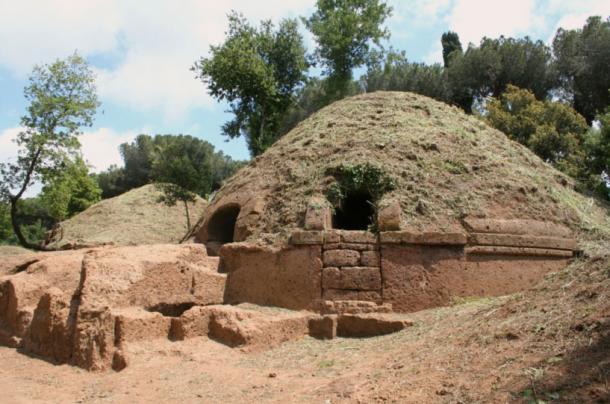
Etruscan tumulus tomb in Cerveteri. Source: BigStockPhoto
Cerveteri is located in northern Lazio in the province of Rome, and is commonly thought to be one of the city states of the Etruscan League. One of the most impressive sites in Cerveteri is the Necropoli della Banditaccia. This necropolis was inscribed in 2004 as a UNESCO World Heritage site, together with the nearby Etruscan necropolis at Tarquinia. The Etruscan settlement of Cerveteri can be dated back to the 9 th century B.C., and its necropolis, which contains thousands of tombs, was in use since the 7 th century B.C. One of the unique features of this necropolis is its urban planning. As this necropolis was organised in a city-like plan, complete with streets, squares and neighborhoods, it is often called a ‘city of the dead’. Additionally, the tombs in the necropolis imitate houses, providing archaeologists with the best and only evidence of Etruscan residential architecture, as such structures have not survived in the archaeological record.
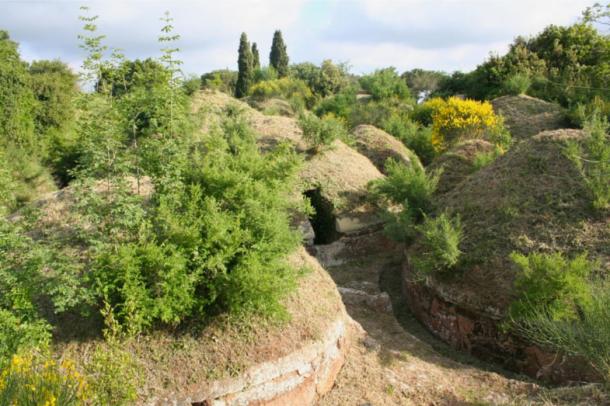
The Etruscan necropolis was organized with a city-like plan. Photo source: BigStockPhoto
The tombs at the necropolis can be classified chronologically. The oldest tombs are dated to the 7 th century B.C., and are identifiable by their characteristic tumulus. These are huge circular mounds, and some of these burial mounds were used by the same family over several generations. It is believed that the use of the tumulus by the Etruscans originated in the Near East, as the 7 th century B.C. is called the ‘Orientalizing Period’, in which various regions of the Mediterranean, including Greece and Italy, were influenced by the art of the Near East. The large tumuli are surrounded by smaller tumuli, suggesting that Etruscan society at that time was hierarchical and was governed by aristocrats.
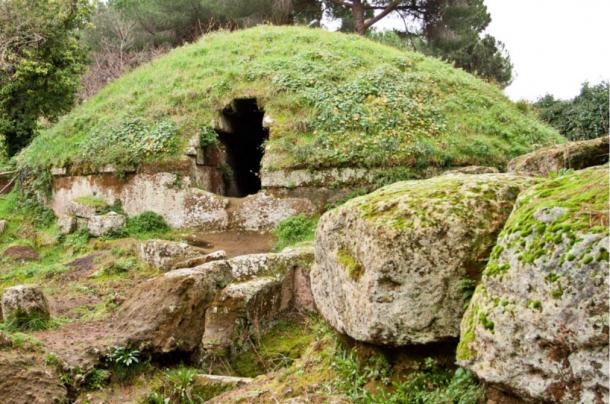
The oldest Etruscan tombs are the large circular mounds. Photo source: BigStockPhoto
Towards the second half of the 6 th century B.C., the tombs in the necropolis are arranged in blocks along parallel streets. This may have been a reflection in the change of Etruscan social structure from an aristocratic one to an egalitarian urban one. The standard appearance of the tombs in the necropolis may have been an indication that there was a more even distribution of wealth in Etruscan society. Incidentally, it was during this century that the Etruscans were at their height of power. During this century, the Etruscan civilization achieved it greatest extent, with new colonies being founded in the Po Valley in the north and on the Adriatic coast in the west. Furthermore, the Etruscans were able to monopolize the trade routes in the western Mediterranean, thus bringing great wealth to their cities.
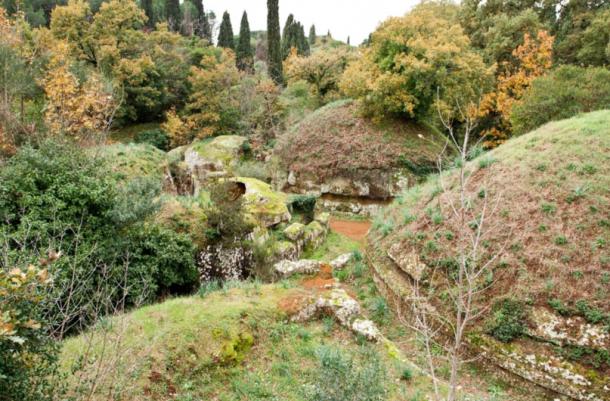
Tumulus tombs in the 'City of the Dead'. Photo source: BigStockPhoto
By the 5 th century B.C., however, the Etruscans were in decline, losing their trade monopoly as well as losing wars against the Syracusans, Romans and Gauls. By the late 4 th century B.C., the Etruscans were assimilated into the Roman Republic. Still, the necropolis at Cerveteri continued to be used. As the available surface space had been exhausted, the subsoil was used instead. Road levels were lowered, and a series of deep underground chambers, known as hypogea, were built for the dead.
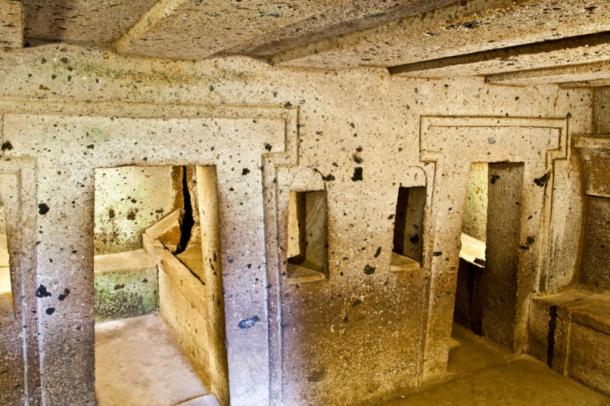
Underground hypogea at Cerverteri. Photo source: BigStockPhoto
One of the most famous tombs in the necropolis, the Tomb of the Reliefs, was built during the 4 th and 3 rd centuries B.C. This tomb belonged to the Matuna family, and contained stucco reliefs depicting household utensils as well as pets, perhaps items that would be required by the deceased family in the afterlife. Furthermore, denizens of the Underworld, such as Cerberus and an anguiped demon, are also represented in the reliefs. Thus, the reliefs may be likened to a snapshot of the Etruscan view of the afterlife. Although the Etruscans were no longer in power, such lavish tombs as the Tomb of the Reliefs is an indication that Etruscan culture continued to survive well into the Roman period.
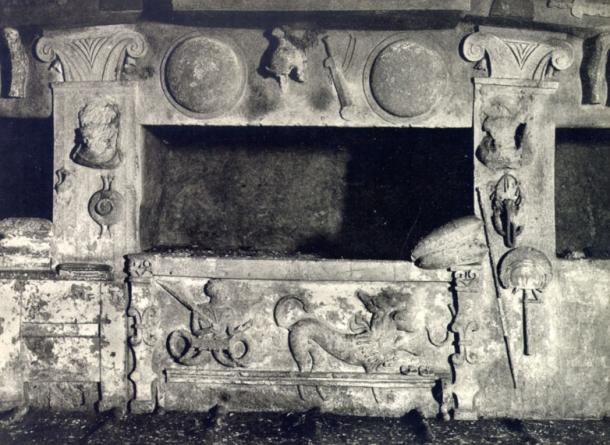
Tomb of Reliefs, Cerveteri. Image Source
Other Etruscan burials have been discovered in recent years, giving further insights into the little known about culture. In 2015, an unlooted Etruscan tomb was found outside of Perugia and in it were found urns, a marble head and two sarcophagi. In 2016, a burial chamber dated to the 8 th century BC was uncovered 3 meters (10 ft) below the surface at the archaeological site Vulci, a former Etruscan city in the province of Viterbo, Italy. This subterranean chamber housed the remains of a young girl who had been encircled by striking jewelry from the period. A total of 17 similar tombs have now been found at the site. In the tomb of one man were found silver rings, bronze ornaments and vases, whilst another girl’s tomb contained gold earrings and two siren statues, reported ANSA at the time of the finds.
Top image: Interior of Etruscan Tomb of the Reliefs, Cerveteri, Italy.
References
UNESCO, 2015. Etruscan Necropolises of Cerveteri and Tarquinia. [Online]
Available at: http://whc.unesco.org/en/list/1158
www.frommers.com, 2014. Cerveteri & Tarquinia. [Online]
Available at: http://www.frommers.com/destinations/rome/705658#sthash.fXVKTMYZ.k2ohYkFG.dpbs
www.italia.it, 2015. The Necropolises of Tarquinia and Cerveteri. [Online]
Available at: http://www.italia.it/en/travel-ideas/unesco-world-heritage-sites/necropolises-of-tarquinia-and-cerveteri.html
www.terraetrusca.eu, 2015. The Etruscan Necropolis of Banditaccia. [Online]
Available at: http://www.terraetrusca.eu/?p=184&lang=en
By Ḏḥwty
















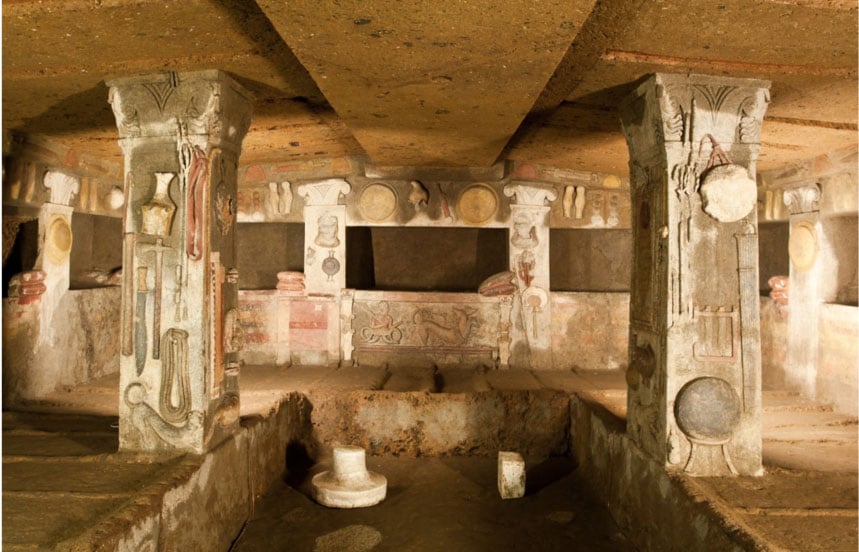

Comments
I always enjoy reading articles about how the ancients treated their dead. Another great article by Ḏḥwty
so where are all the bodies ? all gone ? or are tombs, sealed ? Interested to know !
all the paint gone from walls too ? was it ever flooded ?
What is being done to discover history, builders, purpose, etc of the hundreds of stone passages and 'storage' rooms all throughout New England?? Developers are bull dozing many into oblivion and vandals working their magic on others. What is wrong with Smithsonian, university archaeology departments? Once gone, can't get back. Why is this marvel being ignored??
archaeology